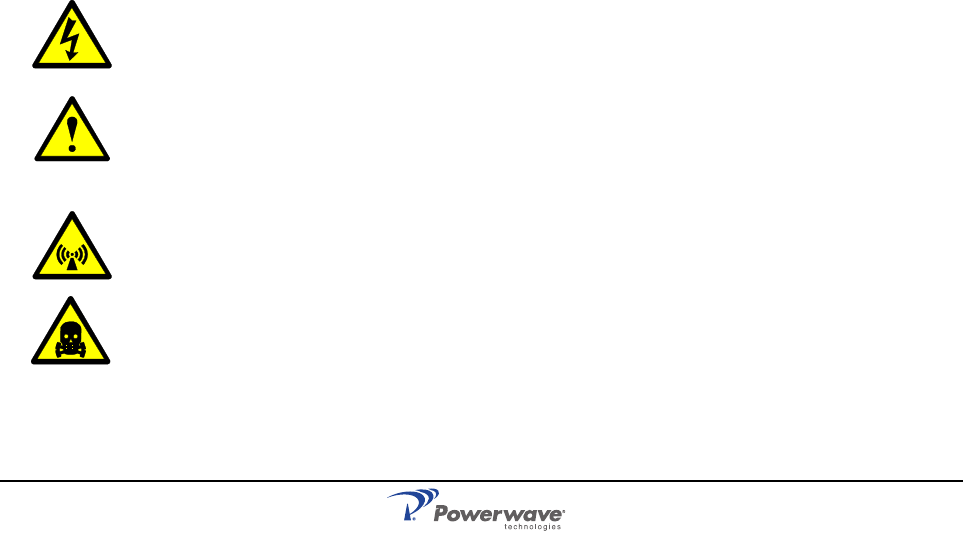User's Manual
Table Of Contents
- Revision Record
- Table of Contents
- List of Figures
- List of Tables
- Abbreviations
- Chapter 1 Product Description
- Introduction
- Scope of Manual
- Safety
- Warning Signs
- Human Exposure of RF Radiation
- Radiation Safety Distances
- Electrostatic Discharge (ESD)
- Sub Unit Overview
- Wideband Amplifier PCBA (WBA)
- Power Amplifier PCBA (PA)
- Multi-Carrier Power Amplifier PCBA (MCPA)
- Booster Amplifier PCBA (BA)
- Distribution PCBA (DIA)
- Control Unit PCBA (CU)
- Low Noise Amplifier (LNA)
- Duplex Filter (DPX)
- Fiber Optic Unit (FOU)
- Fiber Optic Node (FON)
- Power Supply Unit (PSU)
- Remote Control Unit (RCU)
- Alarm Interface PCBA (ALI) and Remote Control Interface PCBA (RCI)
- Sub Unit Locations
- Fiber Optic Distribution Networks
- Multi-Operator Configurations
- Chapter 2 Controls, Indicators and Connectors
- Chapter 3 Installation
- Chapter 4 Maintenance
- Chapter 5 Specifications
- Appendix A Block Diagrams

044-05251 Rev A 1-1
Chapter 1
Product Description
Introduction
This manual contains information and procedures for installation, operation, and maintenance
of the Wideband Radio Head (WRH). The manual is organized into chapters as follows.
Scope of Manual
This manual is intended for use by service technicians familiar with similar types of equipment.
It contains service information required for the equipment described and is current as of the
printing date. Changes which occur after the printing date may be incorporated by a complete
manual revision or alternatively as additions.
Safety
It is necessary that any personnel involved in installation, operation or service of units included
in a Powerwave Distributed Antenna System (DAS) understand and follow the below points.
• Powerwave WRHs are designed to receive and amplify signals from one or more base
stations and retransmit the signals to one or more mobile stations. And, also to act the
other way round, that is to receive signals from one or more mobile stations, amplify
and retransmit the signals to the base stations. Powerwave WRH systems must be
used exclusively for this purpose and nothing else.
• Units supplied from the mains must be connected to grounded outlets and in conformity
with the local prescriptions.
• Power supply units supplied from the mains contain dangerous voltage that can cause
electric shock. Disconnect the mains prior to any work in such a unit. Local regulations
are to be followed when servicing such units. Authorized service personnel only are
allowed to service units while the mains is connected.
• The WRH cover must be secured in opened position, for instance by tying it up.
Otherwise, the cover can be closed by the wind and cause your fingers getting pinched
or your head being hit.
• When working on a WRH on high ground, for instance on a mast or pole, be careful not
to drop parts or the entire WRH. Falling parts can cause serious personal injury.
• All RF transmitting units, including WRHs, will generate radio signals and thereby give
rise to electromagnetic fields that may be hazardous to the health of any person who is
extensively exposed close to an antenna.
• Beryllium oxide (BeO) may be contained in power devices, for instance in dummy loads
in directional couplers (DCC), in combiner units (CMB), and in attenuators on the FON
board. Beryllium oxide is poisonous if present as dust or smoke that can be inhaled. Do
not file, grind, machine, or treat these parts with acid.
• Coaxial cables used in many Powerwave systems have the insulation made of PTFE,
polytetrafluoro ethylene, that gives off small amounts of hydrogen fluoride when
heated. Hydrogen fluoride is poisonous. Do not use heating tools when stripping off
Chapter 1 - Product Description
Chapter 2 - Controls and Indicators
Chapter 3 - Installation
Chapter 4 - Maintenance
Chapter 5 - Specifications










